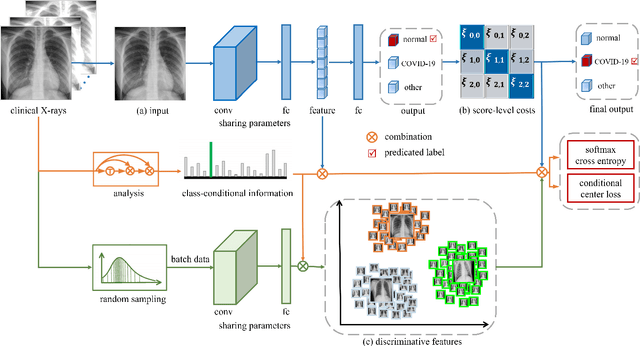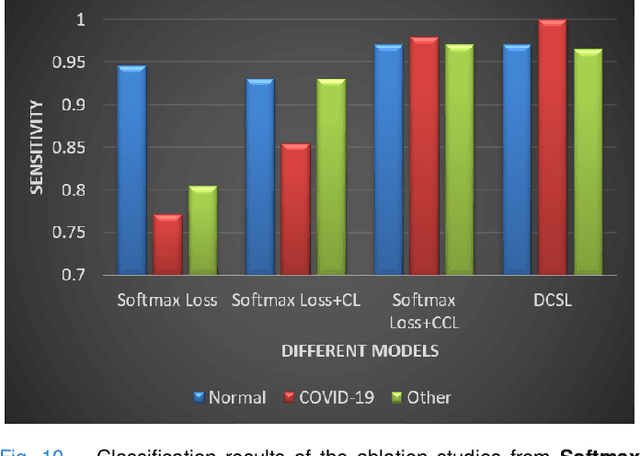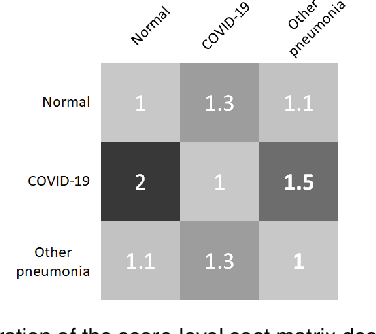Jinyu Cong
BB-GCN: A Bi-modal Bridged Graph Convolutional Network for Multi-label Chest X-Ray Recognition
Feb 22, 2023



Abstract:Multi-label chest X-ray (CXR) recognition involves simultaneously diagnosing and identifying multiple labels for different pathologies. Since pathological labels have rich information about their relationship to each other, modeling the co-occurrence dependencies between pathological labels is essential to improve recognition performance. However, previous methods rely on state variable coding and attention mechanisms-oriented to model local label information, and lack learning of global co-occurrence relationships between labels. Furthermore, these methods roughly integrate image features and label embedding, ignoring the alignment and compactness problems in cross-modal vector fusion.To solve these problems, a Bi-modal Bridged Graph Convolutional Network (BB-GCN) model is proposed. This model mainly consists of a backbone module, a pathology Label Co-occurrence relationship Embedding (LCE) module, and a Transformer Bridge Graph (TBG) module. Specifically, the backbone module obtains image visual feature representation. The LCE module utilizes a graph to model the global co-occurrence relationship between multiple labels and employs graph convolutional networks for learning inference. The TBG module bridges the cross-modal vectors more compactly and efficiently through the GroupSum method.We have evaluated the effectiveness of the proposed BB-GCN in two large-scale CXR datasets (ChestX-Ray14 and CheXpert). Our model achieved state-of-the-art performance: the mean AUC scores for the 14 pathologies were 0.835 and 0.813, respectively.The proposed LCE and TBG modules can jointly effectively improve the recognition performance of BB-GCN. Our model also achieves satisfactory results in multi-label chest X-ray recognition and exhibits highly competitive generalization performance.
Robust Screening of COVID-19 from Chest X-ray via Discriminative Cost-Sensitive Learning
May 21, 2020



Abstract:This paper addresses the new problem of automated screening of coronavirus disease 2019 (COVID-19) based on chest X-rays, which is urgently demanded toward fast stopping the pandemic. However, robust and accurate screening of COVID-19 from chest X-rays is still a globally recognized challenge because of two bottlenecks: 1) imaging features of COVID-19 share some similarities with other pneumonia on chest X-rays, and 2) the misdiagnosis rate of COVID-19 is very high, and the misdiagnosis cost is expensive. While a few pioneering works have made much progress, they underestimate both crucial bottlenecks. In this paper, we report our solution, discriminative cost-sensitive learning (DCSL), which should be the choice if the clinical needs the assisted screening of COVID-19 from chest X-rays. DCSL combines both advantages from fine-grained classification and cost-sensitive learning. Firstly, DCSL develops a conditional center loss that learns deep discriminative representation. Secondly, DCSL establishes score-level cost-sensitive learning that can adaptively enlarge the cost of misclassifying COVID-19 examples into other classes. DCSL is so flexible that it can apply in any deep neural network. We collected a large-scale multi-class dataset comprised of 2,239 chest X-ray examples: 239 examples from confirmed COVID-19 cases, 1,000 examples with confirmed bacterial or viral pneumonia cases, and 1,000 examples of healthy people. Extensive experiments on the three-class classification show that our algorithm remarkably outperforms state-of-the-art algorithms. It achieves an accuracy of 97.01%, a precision of 97%, a sensitivity of 97.09%, and an F1-score of 96.98%. These results endow our algorithm as an efficient tool for the fast large-scale screening of COVID-19.
 Add to Chrome
Add to Chrome Add to Firefox
Add to Firefox Add to Edge
Add to Edge